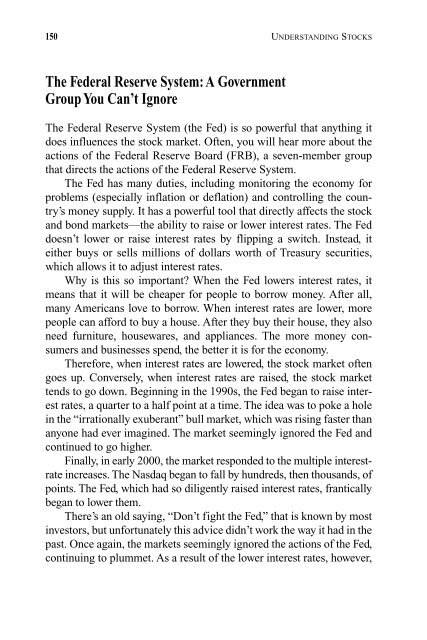Understanding Stocks
Understanding Stocks
Understanding Stocks
Create successful ePaper yourself
Turn your PDF publications into a flip-book with our unique Google optimized e-Paper software.
150 UNDERSTANDING STOCKS<br />
The Federal Reserve System: A Government<br />
Group You Can’t Ignore<br />
The Federal Reserve System (the Fed) is so powerful that anything it<br />
does influences the stock market. Often, you will hear more about the<br />
actions of the Federal Reserve Board (FRB), a seven-member group<br />
that directs the actions of the Federal Reserve System.<br />
The Fed has many duties, including monitoring the economy for<br />
problems (especially inflation or deflation) and controlling the country’s<br />
money supply. It has a powerful tool that directly affects the stock<br />
and bond markets—the ability to raise or lower interest rates. The Fed<br />
doesn’t lower or raise interest rates by flipping a switch. Instead, it<br />
either buys or sells millions of dollars worth of Treasury securities,<br />
which allows it to adjust interest rates.<br />
Why is this so important? When the Fed lowers interest rates, it<br />
means that it will be cheaper for people to borrow money. After all,<br />
many Americans love to borrow. When interest rates are lower, more<br />
people can afford to buy a house. After they buy their house, they also<br />
need furniture, housewares, and appliances. The more money consumers<br />
and businesses spend, the better it is for the economy.<br />
Therefore, when interest rates are lowered, the stock market often<br />
goes up. Conversely, when interest rates are raised, the stock market<br />
tends to go down. Beginning in the 1990s, the Fed began to raise interest<br />
rates, a quarter to a half point at a time. The idea was to poke a hole<br />
in the “irrationally exuberant” bull market, which was rising faster than<br />
anyone had ever imagined. The market seemingly ignored the Fed and<br />
continued to go higher.<br />
Finally, in early 2000, the market responded to the multiple interestrate<br />
increases. The Nasdaq began to fall by hundreds, then thousands, of<br />
points. The Fed, which had so diligently raised interest rates, frantically<br />
began to lower them.<br />
There’s an old saying, “Don’t fight the Fed,” that is known by most<br />
investors, but unfortunately this advice didn’t work the way it had in the<br />
past. Once again, the markets seemingly ignored the actions of the Fed,<br />
continuing to plummet. As a result of the lower interest rates, however,

















